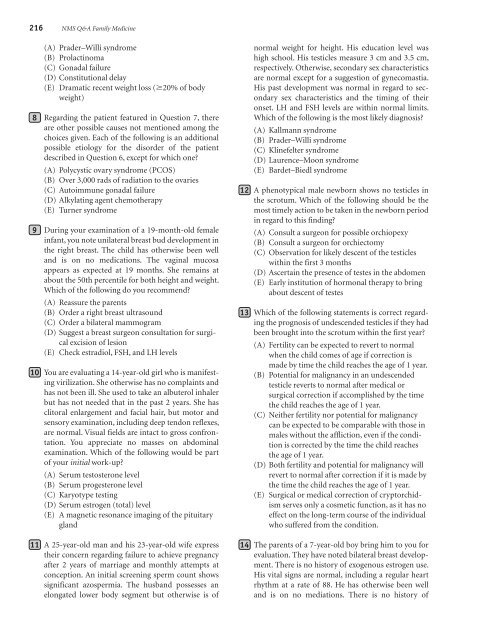NMS Q&A Family Medicine
NMS Q&A Family Medicine
NMS Q&A Family Medicine
- No tags were found...
You also want an ePaper? Increase the reach of your titles
YUMPU automatically turns print PDFs into web optimized ePapers that Google loves.
216 <strong>NMS</strong> Q&A <strong>Family</strong> <strong>Medicine</strong>(A) Prader–Willi syndrome(B) Prolactinoma(C) Gonadal failure(D) Constitutional delay(E) Dramatic recent weight loss ( 20% of bodyweight)8 Regarding the patient featured in Question 7, thereare other possible causes not mentioned among thechoices given. Each of the following is an additionalpossible etiology for the disorder of the patientdescribed in Question 6, except for which one?(A) Polycystic ovary syndrome (PCOS)(B) Over 3,000 rads of radiation to the ovaries(C) Autoimmune gonadal failure(D) Alkylating agent chemotherapy(E) Turner syndrome9 During your examination of a 19-month-old femaleinfant, you note unilateral breast bud development inthe right breast. The child has otherwise been welland is on no medications. The vaginal mucosaappears as expected at 19 months. She remains atabout the 50th percentile for both height and weight.Which of the following do you recommend?(A) Reassure the parents(B) Order a right breast ultrasound(C) Order a bilateral mammogram(D) Suggest a breast surgeon consultation for surgicalexcision of lesion(E) Check estradiol, FSH, and LH levels10 You are evaluating a 14-year-old girl who is manifestingvirilization. She otherwise has no complaints andhas not been ill. She used to take an albuterol inhalerbut has not needed that in the past 2 years. She hasclitoral enlargement and facial hair, but motor andsensory examination, including deep tendon reflexes,are normal. Visual fields are intact to gross confrontation.You appreciate no masses on abdominalexamination. Which of the following would be partof your initial work-up?(A) Serum testosterone level(B) Serum progesterone level(C) Karyotype testing(D) Serum estrogen (total) level(E) A magnetic resonance imaging of the pituitarygland11 A 25-year-old man and his 23-year-old wife expresstheir concern regarding failure to achieve pregnancyafter 2 years of marriage and monthly attempts atconception. An initial screening sperm count showssignificant azospermia. The husband possesses anelongated lower body segment but otherwise is ofnormal weight for height. His education level washigh school. His testicles measure 3 cm and 3.5 cm,respectively. Otherwise, secondary sex characteristicsare normal except for a suggestion of gynecomastia.His past development was normal in regard to secondarysex characteristics and the timing of theironset. LH and FSH levels are within normal limits.Which of the following is the most likely diagnosis?(A) Kallmann syndrome(B) Prader–Willi syndrome(C) Klinefelter syndrome(D) Laurence–Moon syndrome(E) Bardet–Biedl syndrome12 A phenotypical male newborn shows no testicles inthe scrotum. Which of the following should be themost timely action to be taken in the newborn periodin regard to this finding?(A) Consult a surgeon for possible orchiopexy(B) Consult a surgeon for orchiectomy(C) Observation for likely descent of the testicleswithin the first 3 months(D) Ascertain the presence of testes in the abdomen(E) Early institution of hormonal therapy to bringabout descent of testes13 Which of the following statements is correct regardingthe prognosis of undescended testicles if they hadbeen brought into the scrotum within the first year?(A) Fertility can be expected to revert to normalwhen the child comes of age if correction ismade by time the child reaches the age of 1 year.(B) Potential for malignancy in an undescendedtesticle reverts to normal after medical orsurgical correction if accomplished by the timethe child reaches the age of 1 year.(C) Neither fertility nor potential for malignancycan be expected to be comparable with those inmales without the affliction, even if the conditionis corrected by the time the child reachesthe age of 1 year.(D) Both fertility and potential for malignancy willrevert to normal after correction if it is made bythe time the child reaches the age of 1 year.(E) Surgical or medical correction of cryptorchidismserves only a cosmetic function, as it has noeffect on the long-term course of the individualwho suffered from the condition.14 The parents of a 7-year-old boy bring him to you forevaluation. They have noted bilateral breast development.There is no history of exogenous estrogen use.His vital signs are normal, including a regular heartrhythm at a rate of 88. He has otherwise been welland is on no mediations. There is no history of
















